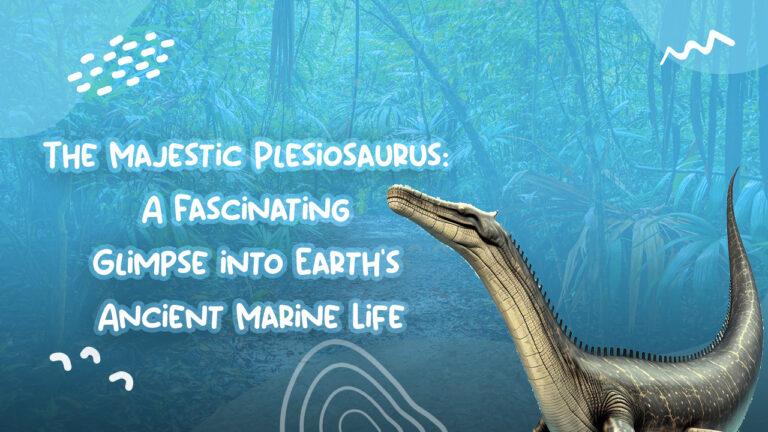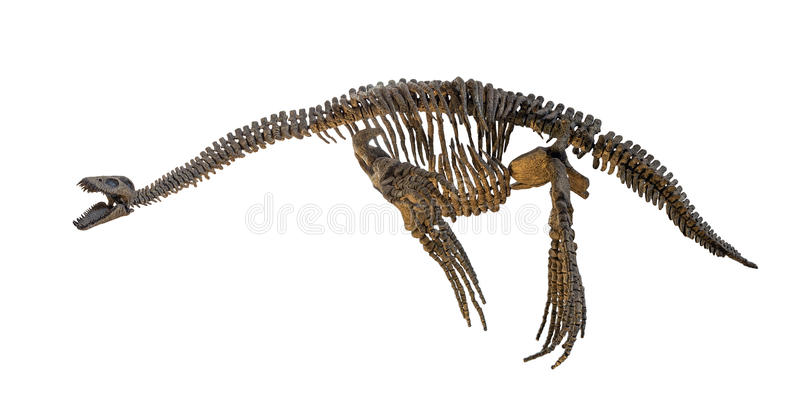Majestic Plesiosaurus – Cool Marine Life

For those who have ever dreamed of uncovering a dinosaur fossil, one of the most remarkable discoveries in recent times is the Plesiosaurus skeleton.
This Jurassic-era aquatic reptile was discovered by a research team in Dorset, England. Let’s take a look at this unique fossil and explore what it can tell us about ancient life.
What Is Plesiosaurus?
The plesiosaurus was an aquatic reptile that lived in the ocean during the Jurassic period. It had four long flippers and a short tail, which made it well-adapted to living in the water.
Its body was streamlined and its head had two large eyes that allowed it to see underwater. Plesiosaurus were predators, their diet included animals such as fish and squid.
A Brief History of Plesiosaurus Discoveries
The Plesiosaurus first came to our attention in the early 19th century when British fossil collector Mary Anning discovered a “petrified skeleton” in Lyme Regis, England. This groundbreaking find marked the start of the paleontological fascination with marine reptiles.
Over the years, numerous Plesiosaurus fossils have been unearthed all around the globe, including the United States, Europe, Asia, and Australia. These discoveries have shaped our understanding of the anatomy and ecology of these prehistoric marine predators.
The Anatomy of a Plesiosaurus
A plesiosaurus skeleton is both complex and awe-inspiring. Their most distinctive feature is the elongated neck consisting of around 40 individual vertebrae, which allowed for remarkable flexibility and precision when capturing prey. As ocean-dwelling reptiles, their bodies were streamlined for efficient movement through the water.
Plesiosaurus possessed four large, paddle-like limbs, making them powerful and agile swimmers. A rigid, interlocking backbone provided necessary stability, while the tail enabled quick changes in direction when hunting.
Classification and Family Tree
Plesiosaurs belonged to the order Plesiosauria, which thrived during the Jurassic and Cretaceous periods. This order encompasses a large diversity of body shapes and sizes, with some species exhibiting shorter necks and larger heads, resembling the pliosaurs. Plesiosauria comprises two major families: Plesiosauridae and Elasmosauridae.
While plesiosaurids are renowned for their shorter necks and robust bodies, elasmosaurids are characterized by their exceptionally long necks and small heads.
Details of the Discovery
The Plesiosaurus skeleton was discovered by chance during an excavation by researchers at Durlston Bay in England. When they uncovered its bones, they suspected it was from a plesiosaur because of its long flipper arms and neck vertebrae. After painstakingly excavating around 170 bones, they were able to reassemble them into a complete skeleton—the first such find of its kind in decades!
The researchers also unearthed several other fossils including ammonites (an extinct type of mollusk), shark teeth, and marine mammal skeletons, giving us an invaluable glimpse into life during that time period.
Significance Of The Find
The discovery of this plesiosaur has shed light on our understanding of marine reptiles from prehistoric times. Researchers believe that these creatures may have been much more agile than previously thought and even capable of swimming long distances with ease due to their streamlined bodies and powerful flippers.
Additionally, this specimen provides evidence for how some species adapted to their environments over time—in particular how some aquatic reptiles evolved longer necks to help them feed on prey further away from their bodies while still staying hydrodynamic enough to swim efficiently through water.
Plesiosaurus Skeleton–Insights into Prehistoric Life
The discovery of the Plesiosaurus skeleton provided researchers with valuable information about prehistoric times. Not only did it shed light on the physical characteristics of this fascinating creature but also its behavior and environment.
By studying the fossils, scientists were able to learn more about how these creatures adapted over time and their role in ancient ecosystems. In addition, Mary Anning’s work helped establish paleontology as its own branch of science and paved the way for future discoveries in this field.
A Plesiosaurus Skeleton Is Both Complex and Unique
The Plesiosaurus skeleton consists of over 200 bones, which makes it one of the most complex skeletons in existence. The majority of its bones are located in its long neck, which can reach up to ten feet in length!
This impressive feature allowed the Plesiosaurus to feed on small fish and other prey they could snatch up with their long necks. Plesiosaurs also had four large flippers that gave them speed and maneuverability underwater. Their tails were powerful as well and helped them propel themselves through the water with ease.
Unique Features
Plesiosaurus also has some unique features that set them apart from other prehistoric reptiles. One is their rib cage, which is made up of overlapping plates called “gastralia” that provide additional support for their long necks. They also have an unusually shaped head with two sets of teeth – one set on each side.
Which allowed them to capture prey more efficiently than other predators at the time. Lastly, their vertebrae are much thicker than those of any other animal from this period, providing added protection against predators such as sharks or octopuses who might have tried to attack them while swimming in open waters.
Diet and Behavior of Plesiosaurs
The elongated neck of the Plesiosaurus hints at its unique hunting strategy. It is believed that these creatures utilized their long necks to approach prey undetected or to ambush them from below.
Plesiosaurus diet likely consisted primarily of fish and other marine life, but it is possible that they also scavenged on carcasses of deceased animals. Plesiosaurs had a vast range, occupying both shallow waters and deeper ocean depths, making them highly adaptable hunters.
Ongoing Research and New Insights
Despite the numerous skeletons discovered, many aspects of their biology and behavior remain shrouded in mystery. Recent advancements in technology, such as 3D scanning, have allowed scientists to gain a more accurate understanding of how these ancient creatures lived and thrived.
Additionally, ongoing research on well-preserved fossil specimens continues to provide new insights into their ecology, evolution, and extinction. Excavations worldwide continue to unearth fascinating clues about the enigmatic lives of these captivating marine reptiles.
Conclusion
The skeletal remains of a plesiosaurus provide us with invaluable insights into prehistoric times that would not have been possible without Mary Anning’s groundbreaking work over 200 years ago.
Through her contributions, she laid the foundation for further scientific discoveries that are still being made today—and her legacy will continue to inspire future generations of scientists for years to come! Long after she has passed away, we can still appreciate what she accomplished with her remarkable fossil finds.
Read more amazing facts about dinosaurs Shuvuuia Dinosaur: The Dinosaur Who Loves the Nightlife.

Top posts
related articles
Discover The Top 10 Longest Dinosaur Names
Dinosaurs, the ancient giants that once roamed the Earth, continue to capture our imagination. While
Discover the Amazing Dinosaur with 500 Teeth
Dinosaurs have always fascinated us with their colossal size, unique features, and intriguing mysteries. One
Acheroraptor – Tiny But Fierce Dinosaur
The dinosaur world is undoubtedly fascinating, and the relative discovery of the Acheroraptor is no
Amazing Cryolophosaurus- An Epic Tale
Cryolophosaurus, also known as the ‘Antarctic King’, was a fierce and fascinating dinosaur that existed
Discover Torosaurus And Its Mysterious Identity
Dinosaurs don’t exist anymore, but their fossils still fascinate us. Paleontologists scour the earth to
Corythosaurus–Exploring Its Wondrous World
The world of dinosaurs never stops fantastic us. From the huge T-rex to the tiny


